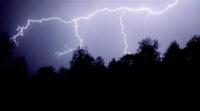Storm Ready
Experts predict El Niño weather pattern to ease severe hurricane season

Photo courtesy of Iowa Legends Roofing & Remodeling.
Though inherently unpredictable, storms are a profit center for the roofing industry and have been critical to roofing contractors' bottom lines in many markets in recent years.
With much of the concerns over the supply chain behind them — and a solid start to this year’s storm season already underway — roofers and distributors are looking forward to brisk business in the upcoming months.
Much of that anticipated business depends on how the market reacts to the El Niño weather pattern, analysts say. The National Oceanic and Atmospheric Administration officially declared the La Niña season — when ocean temperatures are cooler than normal — officially over after two years in March. Forecasters expect a transition period through early summer before El Niño conditions, when warmer ocean temperatures circulate, creating more precipitation and warmer weather throughout the season — and into the winter — develop.
“This spring has been an incredibly active storm season with above-average hail and wind damage across the country,” said Allan York, senior vice president and general manager of construction with EagleView Technologies. “While we are ready to support hurricane season, our team predicts El Niño will make 2023 a less severe hurricane season than 2022.”
Hurricane Ian’s Hangover
While roofing contractors may have dealt with fewer hailstorms in Tornado Alley or experienced less severe weather along the coasts last year, one particular storm punctuated the entire storm season.
Hurricane Ian struck Florida’s west coast in late September with winds nearly reaching 160 mph and a life-threatening storm surge that forced widespread evacuations in multiple states before dissipating about a week later. According to official reports, the Category 4 storm caused 152 deaths and an estimated $113 billion in damage, making it the third-costliest storm on record.
In Florida alone, more than 2 million people were without power for weeks, and roofing contractors had their work cut out for them trying to respond. Many that came from out of state to meet the need established long-term plans to stay given the scope of the work and demand for materials.
“Hurricanes are tough situations to deal with, but that particular storm is a different dynamic,” said Brad Resch, president of Gulfeagle Supply.
Headquartered in Tampa, Fla., and with several of its 110 branches in the Sunshine State, Resch has kept a close eye on the recovery process, noting it is far from over. He described that many uninhabitable buildings and debris are still being cleared, and some businesses have not — and likely may not — return.
While repairs continue in Florida, one positive Resch sees is that concerns over material availability before this year’s hurricane season are fairly low.
“Let's face it, when a storm hits, we get busy, and we max our capacity, and we only have so many trucks, so much material, and … so many contractors,” he said. “I haven’t seen that the storms in some of the markets we’re in have dramatically affected demand yet; maybe that will show itself in the months to come, but it has not in the short term.”

A before-and-after shot of Calcasieu Parish, La., from Hurricane Laura.
Image courtesy of EagleView.
Storm Strategies
However, the rapidly changing nature of storms means that material demand may change quickly, sometimes with even just one extreme weather event. The team at Houston-based Stellar Commercial Roofing knows that well.
Built off of jobs generated by the record number of damaging hailstorms throughout Texas in 2011, Stellar’s national sales team had to change focus from its traditional business model due to a dearth of severe storms in 2021. While damaging hail was less prevalent, hurricane season still proved busy.
Stellar officials said the company leveraged the ferocity of Hurricane Ida that struck Louisiana in late August 2021 with its new approach, which turned into one of the company’s most successful years, revenue-wise.
“We had a year of little hail damage to pursue, so we chose to overcome that obstacle with new sales team approaches across the lower 48,” said Office Manager Kelley Cote. “These strategies and venturing into our first hurricane … we successfully navigated new territory and capitalized on revenue we had not previously pursued.”
The success carried over into 2022, and this year the company is targeting 15% growth; it added more than 20 workers to work on national accounts to handle increased demand.
As in years past, roofers can expect a strong storm season in the Northern Plains through June and July, according to forecasters with HailTrace, a weather-tracking and data-collection software company that serves roofing contractors nationwide. CEO Derik Kline said that could include a derecho storm or two in typical spots like Iowa and Nebraska. However, they won’t likely be as troublesome as the 2020 storm that left 800 miles of destruction across Iowa, Illinois, Indiana, Nebraska and Wisconsin.
“Typically, one at that level happens about once every 10 years,” Kline said, adding that derechos happen in late June, July and August because they’re generated by the summer heat.
After a brief respite from major storms in July, Kline said his team’s focus typically turns to the tropics by early August.
Unlike hail storm response, Kline, a storm chaser for two decades, said he usually gets three-to-five days warning before a significant tropical storm, or hurricane, bears down on the Atlantic or Gulf coasts.
“Our goal with a hurricane is to get there between 12 and 24 hours before landfall,” Kline said. “That allows us to get a scope of the land and understand where there are safe places in case it gets really bad and we can’t be out in the elements anymore. Because once you’re in it, you’re in it.”

Damage from Hurricane Laura, a Category 4 storm that generated winds around 150 mph.
Photo: Superb Roofing.
The Outlook
At press time, NOAA had not released its formal forecast for the 2023 Atlantic hurricane season. If any major storms develop in the Gulf or Caribbean and then make landfall, expect the damage to be in the billions, based on infrastructure, property concentration and high property values along the coasts, Kline said.
Two pockets Kline is paying attention to this storm season include the Minneapolis, Minn. area, stretching to northern Iowa and eastern Oklahoma, Texas and Arkansas.
“There’s already been a lot of activity in those areas, so expect that to continue,” he said. “There’s still a lot to look at, but most likely, we’ll be looking at a below-average hurricane season because El Niño and hurricanes don’t mix.”
That said, there will still be plenty of work for roofers ready to capitalize. Kline said he had noticed a tendency over the past few years for hurricanes to intensify faster as they approach the shores, making their damage potential much higher.
“In the 1990s and 2000s, the storms tended to weaken as they got closer to the coasts, and recently they’ve been intensifying as they get close. I wouldn’t bet against it until proven otherwise,” Kline warned.
While they can’t really plan too well ahead due to all the variables in climate, Resch said all Gulfeagle branches in the areas impacted by storms in the past have standard operating procedures that get tested year after year.
“We don’t really know when or where it will hit, but we’re on the ready every year,” he explained. “We know the drill and know what to do.”
Among the benefits roofing contractors can enjoy now, perhaps more than in years past, are the new technological tools that can make storm response safer for roofing contractors.
EagleView’s York said the company’s recent release of the EagleView Assess — which creates reports from autonomous drone-sourced property intelligence — is a game-changer for roofer safety.
“RC recently reported a 20% increase in year-over-year roofing fatalities. By using aerial imagery for measurements and drones for post-storm damage detection and proof, contractors can reduce their risk,” he said.
Looking for a reprint of this article?
From high-res PDFs to custom plaques, order your copy today!






